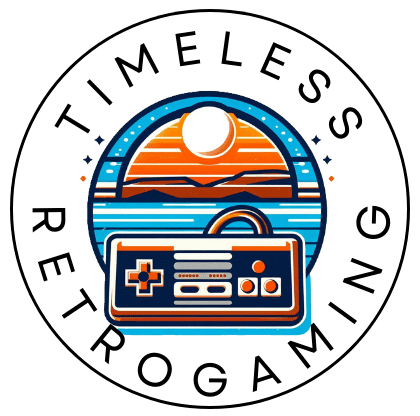
Sierra made a huge splash in the 80s, taking the gaming world by storm. This was a time when video games were transitioning from simple arcade shooters to more complex and engaging storytelling experiences.
Sierra was right at the forefront of this shift. Their games were interactive stories, letting players explore, solve puzzles, and use their wits to progress. This approach resonated with gamers who were hungry for more than just high scores.
At the heart of Sierra’s success were Ken and Roberta Williams, the power couple of 80s video gaming. Roberta, a visionary in game design, created and designed many of Sierra’s most beloved games. Ken, on the other hand, handled the business side, ensuring the company had the resources to support innovative projects. Their synergy was a driving force behind Sierra’s groundbreaking titles.
Sierra’s rise was also aided by leaps in technology. Personal computers were becoming more accessible, and new graphics and sound capabilities meant games could be more immersive. Sierra capitalized on these advancements, pushing the boundaries of what video games could be. Their titles often featured lush 2D graphics and rich narrative elements that were unheard of at the time.
The 80s were a golden era for Sierra, a period when they set the stage for how adventure games could be crafted. It was a time of experimentation and growth, both for the industry and for Sierra as a company. Their influence opened up endless possibilities for video game storytelling, setting a high bar for others to follow.
Iconic Sierra Adventure Games of the 1980s
The 80s were buzzing with Sierra’s releases, each one adding a fresh twist to the adventure game genre. One of the most iconic series to come from this era was ‘King’s Quest’. Designed by Roberta Williams, ‘King’s Quest’ whisked players away to a fantasy kingdom where they tackled riddles and puzzles, all while trying to rescue damsels and recover lost treasures. It was like a fairy tale that you could interact with.
Then came ‘Space Quest’, which took things to a hilarious new level. This series followed the misadventures of janitor-turned-hero Roger Wilco. Mixing sci-fi with slapstick comedy, ‘Space Quest’ featured plenty of tongue-in-cheek humour along with its intergalactic puzzles. It was a breath of fresh air, combining the nerdy charm of space operas with comedic antics that kept players entertained.
We can’t talk about Sierra without mentioning ‘Leisure Suit Larry’. This one pushed the boundaries and raised a few eyebrows with its adult humour and cheeky protagonist, Larry Laffer. Navigating through Larry’s escapades in search of love (or something resembling it) offered a mix of risqué comedy and challenging gameplay. It wasn’t just about laughs; these games had some serious puzzles that kept players engaged.
What set these games apart wasn’t just their engaging storylines, but also the innovative features Sierra incorporated. Many Sierra games introduced the concept of a point-and-click interface, which made them more accessible to a wider audience. They also offered richly detailed worlds that encouraged exploration and curiosity. Players could interact with almost everything on the screen, discovering hidden secrets and easter eggs.
Each of these games created a unique experience that went beyond just completing levels. They were about stepping into another world, solving its mysteries, and having a good time while doing it. These elements combined to create a gaming experience that was both immersive and unforgettable.
Impact on Gaming Culture and Legacy
Sierra’s adventure games in the 80s weren’t just games; they were trendsetters that laid the foundation for storytelling in video games. Before Sierra, games were mostly about scoring points or simple puzzles, but titles like ‘King’s Quest’ and ‘Space Quest’ introduced intricate plots, memorable characters, and think-on-your-feet challenges.
These games gave players something new: a sense of being part of a living story. Instead of just blasting away at enemies, you had to solve problems, interact with characters, and make decisions that impacted the outcome. This approach turned casual gamers into dedicated fans who eagerly awaited each new Sierra release.
The cultural impact was huge. Sierra games were talked about in gaming circles and even in some mainstream media. They had fan followings that rivalled popular TV shows and movies. Fan art, forums, and walkthrough guides became common as players shared their experiences and tips. These communities were the early predecessors of today’s online gaming forums.
The legacy of Sierra’s 80s adventure games can be seen in how modern adventure games are designed. Many contemporary game developers grew up playing Sierra titles and carried that inspiration into their creations. The point-and-click interface, branching storylines, and deep character development found in many of today’s games are all nods to Sierra’s pioneering efforts.
Even indie developers are influenced by Sierra’s legacy. The spirit of creativity and pushing boundaries, features that defined Sierra’s games, can be spotted in numerous indie titles today. Whether it’s through remakes or new games inspired by classics, the echoes of Sierra’s 80s adventure games continue to resonate.
Tips for Modern Gamers Exploring Classic Sierra Titles
For those interested in experiencing the magic of Sierra’s classic adventure games, there are plenty of ways to dive in today. Thanks to modern platforms, getting ahold of these retro wonders is easier than ever!
Digital distribution platforms like GOG.com and Steam have many of Sierra’s iconic titles in their libraries. These platforms have often updated the games to run smoothly on modern operating systems. No need to dust off that old floppy disk collection!
Another great option is exploring remastered versions of these classic games. Some titles have been given a fresh coat of paint with updated graphics and sound while staying true to the original gameplay and story. These remakes offer a nostalgic trip for old fans and a polished introduction for new players.
Using tools like DOSBox can also help modern gamers run original Sierra games on today’s computers. DOSBox emulates the old-school DOS environment, letting you play the classics just like back in the day. It might take a little setup, but the payoff is diving back into those pixel-perfect worlds just as they were.
Connecting with the community can enhance your experience. Sites like the Sierra Help Pages offer forums, guides, and downloads to help you navigate the quirks of older games. Engaging with other fans can provide tips, tricks, and a shared sense of nostalgia that makes playing these classics even more fun.
Whether through official re-releases, remastered editions, or community forums, discovering Sierra’s gem-filled past is an adventure in itself. These games aren’t just a slice of history; they’re still fun, engaging, and worth every bit of your time. Happy adventuring!
More Information on Ken and Roberta Williams and Sierra games.
- PC Gamer’s Article on Sierra’s Legacy – PC Gamer offers a deep dive into Sierra’s influential role in the gaming industry, detailing how Roberta Williams’ design of King’s Quest and other titles helped redefine adventure gaming. It also touches on how modern developers continue to draw inspiration from Sierra’s work, including its commitment to immersive storytelling and groundbreaking design.
- GOG’s History of Sierra On-Line – This retrospective looks at the impact Sierra had on the gaming industry. It highlights key series like King’s Quest, Leisure Suit Larry, and Gabriel Knight, while also discussing the company’s pioneering use of new technologies like point-and-click interfaces. The article provides background on Roberta’s influential role in storytelling within games, alongside Ken’s strategic leadership during the company’s most innovative period.

